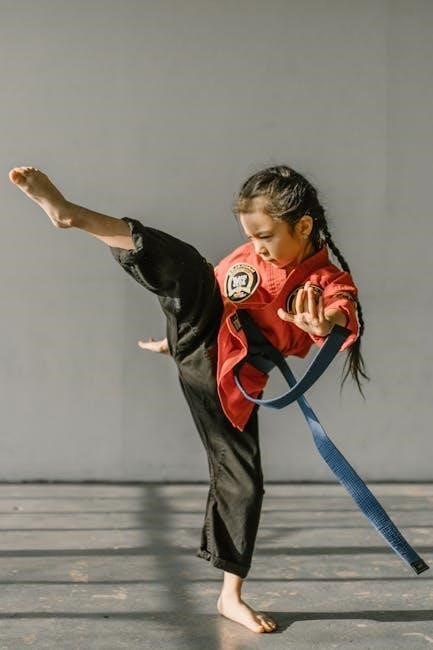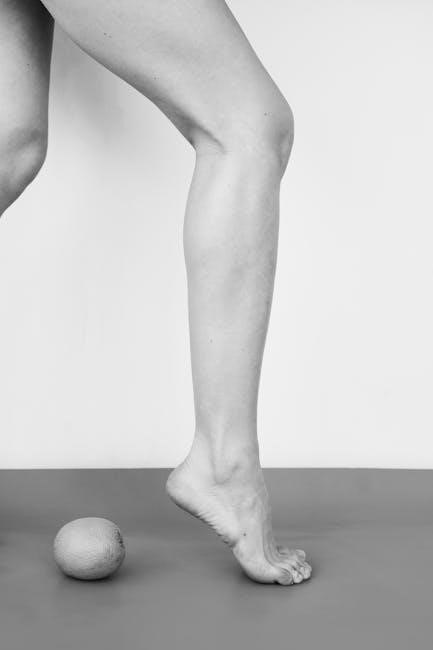The single leg stance test is included in FUNfitness screening for Special Olympic athletes to determine balance education needs via pdf resources online available now everywhere easily always.
Purpose of the Test
The purpose of the single leg stance test is to assess balance and postural steadiness in individuals, which can be useful in identifying those who may be at risk of falls or other mobility issues. According to various online resources, including pdf documents, the test is often used in clinical and athletic settings to evaluate an individual’s ability to maintain balance on one leg. The test is also used to determine if balance education and/or referrals are needed, particularly in populations such as Special Olympic athletes. By evaluating an individual’s ability to perform the single leg stance test, healthcare professionals and coaches can identify areas for improvement and develop targeted interventions to enhance balance and reduce the risk of injury. Additionally, the test can be used to monitor progress and track changes in balance ability over time, making it a valuable tool in a variety of settings. Overall, the purpose of the single leg stance test is to provide a simple and effective way to assess balance and inform treatment or training decisions.
Importance of the Test
The single leg stance test is a crucial assessment tool, as evident from various pdf resources available online, that plays a significant role in evaluating an individual’s balance and postural steadiness. The importance of the test lies in its ability to identify individuals who are at risk of falls, which is a major concern, particularly among the elderly population. By using the single leg stance test, healthcare professionals can take proactive measures to prevent falls and related injuries, thereby improving overall health and well-being. The test is also important for athletes, as it helps to identify areas for improvement and inform training decisions. Furthermore, the single leg stance test is a simple and cost-effective assessment tool that can be administered in a variety of settings, making it an essential component of any comprehensive balance assessment protocol. Its importance is further emphasized by its inclusion in various clinical guidelines and assessment protocols, as outlined in numerous online pdf documents.

Administration of the Test
Test administration involves instructing patients to stand on one leg via pdf guidelines always easily online now available everywhere.
Instructions for the Test
The instructions for the single leg stance test are straightforward and easy to follow, as outlined in various pdf resources available online. The patient is asked to stand on one leg, with the other foot lifted off the ground. The test is typically performed with eyes open and hands on the hips, as this helps to maintain balance and stability. The patient is instructed to stand on one leg unassisted, and the timing begins when the patient’s foot leaves the ground. The test ends when the patient’s foot touches the ground again or when their hands leave their hips. It is essential to provide clear and concise instructions to ensure the patient understands the test procedure and can perform it correctly. The test can be repeated on both legs to assess balance and stability on each side. By following these instructions, healthcare professionals can accurately administer the single leg stance test and obtain reliable results.
Timing of the Test
The timing of the single leg stance test is a crucial aspect of the assessment, as outlined in various pdf resources available online. The test begins when the patient’s foot leaves the ground and ends when the patient’s foot touches the ground again or when their hands leave their hips. The duration of the test is typically measured in seconds, and the patient’s ability to maintain balance and stability on one leg is evaluated. A cut-off time of 10 seconds has been suggested as a threshold for identifying individuals with balance impairments, according to research studies. The timing of the test can be performed using a stopwatch or a digital timer, and it is essential to ensure that the timing is accurate and reliable. By measuring the duration of the test, healthcare professionals can assess the patient’s balance and stability and make informed decisions about their treatment and rehabilitation. The timing of the test is a critical component of the single leg stance test.

Interpretation of Results
Results are interpreted based on duration via pdf guidelines and balance ability assessment always online easily everywhere now available.
Threshold for One-Leg Standing Balance Test
The threshold for the one-leg standing balance test is a crucial aspect of assessing balance ability, with research suggesting a cut-off time of 10 seconds for fall history in certain subjects, as indicated in various pdf resources. This threshold is considered optimal for determining the need for balance education and referrals. According to studies, a one-leg stance test time of less than 10 seconds may indicate poor balance ability and increased risk of falls. The threshold value can be used to identify individuals who require further assessment and intervention to improve their balance and reduce the risk of falls. By using this threshold, healthcare professionals can develop effective strategies for preventing falls and promoting overall health and well-being, with detailed information available in pdf format online. The test is a valuable tool for assessing balance ability and can be used in conjunction with other assessments to provide a comprehensive evaluation of an individual’s overall health.
Research on the Test

Research on the single leg stance test has been conducted to evaluate its effectiveness in assessing balance ability, with studies published in various pdf formats. Researchers have investigated the test’s reliability and validity, as well as its ability to predict fall risk. The test has been shown to be a reliable and valid measure of balance ability, with high test-retest reliability and strong correlations with other balance assessments. Studies have also examined the test’s ability to distinguish between individuals with different balance abilities, such as those with and without a history of falls. The results of these studies are available in pdf format and provide valuable insights into the test’s usefulness as a clinical assessment tool. Overall, the research suggests that the single leg stance test is a useful tool for assessing balance ability and can be used in a variety of clinical and research settings, with detailed information available online.
The single leg stance test concludes with online pdf resources summarizing its importance and application in various fields always easily available now everywhere online.
The single leg stance test is a simple yet effective method for assessing balance and postural stability, with results available in pdf format online. This test is commonly used in various fields, including sports medicine and physical therapy, to evaluate an individual’s ability to maintain balance on one leg. The test is typically performed with the eyes open and hands on the hips, and the time it takes for the individual to lose balance is recorded. A longer time indicates better balance and postural stability. The test can be used to identify individuals who may be at risk of falls or other balance-related problems, and to monitor progress during rehabilitation or training programs. Overall, the single leg stance test is a useful tool for assessing balance and postural stability, and its results can be easily accessed and shared via pdf resources online, making it a convenient option for healthcare professionals and researchers.
Future Directions

Future research on the single leg stance test may focus on developing more advanced methods for assessing balance and postural stability, such as using pdf resources to create personalized training programs. Additionally, the test could be modified to include more challenging conditions, such as standing on a foam pad or with eyes closed, to better simulate real-life situations. The use of technology, such as wearable sensors and mobile apps, could also be explored to make the test more accessible and convenient. Furthermore, the test could be used in conjunction with other assessments, such as cognitive and emotional evaluations, to gain a more comprehensive understanding of an individual’s overall health and well-being. By continuing to develop and refine the single leg stance test, researchers and healthcare professionals can work together to improve balance and postural stability in individuals of all ages and abilities. The test’s results can be easily shared and accessed via pdf resources online, facilitating collaboration and knowledge-sharing among experts.

